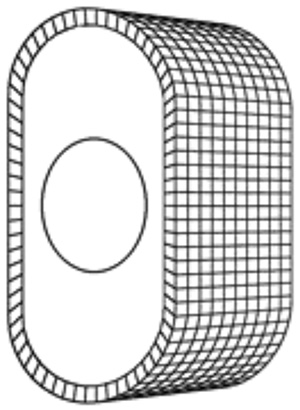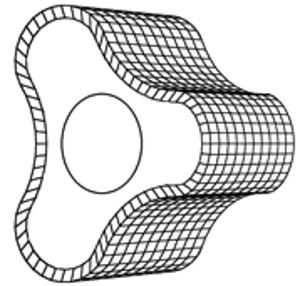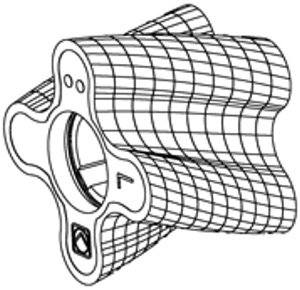Sugar processing requires pumping heavy and sometimes abrasive liquids such as molasses, black liquor, magma and tailings. The liquids are often hot and tend to quickly crystallize if the product remains inside pumps and lines and then cools. A heavy, industrial positive displacement pump is required to handle such applications. Because of advancements in wet-end and overall pump design, rotary lobe pumps offer significant advantages to sugar processors—such as improved product handling, lower life-cycle costs and reduced maintenance.
Rotary lobe pumps are part of the positive displacement group. They create flow by trapping liquid from the suction side, carrying it through the pump and expelling it out the discharge side. During operation, two rotors mesh together and rotate in opposite directions (see Figure 1). The rotation forms cavities between the rotors and wet-end housing. The liquid that fills the cavities is carried through the pump and expelled out the discharge side.
 |
| Figure 1. Rotary lobe pump operation |
Molasses
The major hurdles when dealing with molasses (the “mother liquor” in sugar processing) are viscosity, temperature and crystallization. Molasses is available in many varieties. Each type differs in viscosity and solids content depending on its source—cane, sugar beets or another source.
During processing, molasses can be hot—at times approaching 150 F. All factors combined, molasses can be a tough application for pumps.
Viscosity
Rotary lobe pumps are designed to operate with different levels of slip. The slip is induced because the rotor tips do not touch the pump housing. As viscosity increases, the slip drastically decreases, and the overall efficiency of the pump increases as a result. This also applies to other positive displacement pumps commonly used for molasses, such as gear pumps. They too become more efficient as viscosity increases.
The rotary lobe pump is advantageous for processes involving molasses. Although slip is a factor, it is not as detrimental to the overall efficiency as some other positive displacement pump designs. These pumps are well-suited to handle thinner first molasses up to heavy, black strap molasses without a major change in performance.
Temperature
Temperature affects rotary lobe pumps differently depending on the wet-end materials chosen by the manufacturer for each application. Material options vary among brands. Some manufacturers offer elastomer-coated rotors that use materials such as nitrile rubber (NBR) or ethylene propylene diene monomer (EPDM). These materials are great solutions for molasses pumping as long as the liquid never surpasses 165 F. The elastomer can handle these temperatures, but they tend to swell, which leads to damage to the rotors if the pump seizes.
The other caveat to using elastomers is an understanding of how the facility’s maintenance staff cleans the equipment. If steam is used to clean inside the lines, pumps and other devices, then using elastomers is not an option. The high temperature of the cleaning process can cause catastrophic damage to elastomer-coated rotors.
Many manufacturers also offer solid metal rotors. Metal rotors are available in materials from mild steel, hardened steel, coated steel (such as tungsten carbide) and stainless steel. Brands that offer elastomer-coated and solid metal rotors typically specify the coated version if possible. Elastomer-coated rotors are less expensive and better if solids are present in the pumped fluid. Solid metal rotors require precision machining. They also have the added cost of simply needing more metal compared to a rough casted core.
Added costs aside, molasses applications often require solid metal rotors. An advantage is that solid metals handle high temperature and high abrasives exceptionally well. The pump will be well-suited for operation in a process with unpredictable viscosity and temperature conditions. In addition, the pump would be unaffected if steam cleaning of the system is required.
Crystallization
The natural hardening process that occurs as molasses cools requires thorough cleaning of the system after a run of product to prevent build-up and clogging. This affects many aspects of the overall system but can be particularly hard on pumps if they are not configured properly for the application. Seals are particularly vulnerable to crystallized molasses build-up. Manufacturers offer many sealing systems—from basic packing-style seals to split-face mechanical seals and water-flush mechanical sealing systems.
Each seal system design has its advantages and disadvantages. Even with adequate system cleaning, pump seals will experience some degree of crystallized molasses. The ideal seal choice will handle a reasonable degree of build-up and prevent product leakage.
Sometimes seal choice is simply a matter of factoring cost and maintenance against performance. Pumps that use low-cost and low-maintenance packing-style seals often allow gallons of molasses to leak out of the pump and onto the floor. Conversely, pumps with complex water flush systems to maintain seal lubrication ensure that the product remains in the pump, but complex systems can add cost and maintenance time.
A happy medium in terms of maintenance and performance can be found in brands that use a cartridge mechanical seal that is back-pressurized and compatible with high-temperature and abrasive liquids.
The back pressure comes from adding positive pressure to a buffer chamber behind the seals. This neutralizes the combined pressure in the wet-end and prevents the seals from experiencing excess pressure.
Mud Clarifier/Thickener Underflow
Depending on the size of the clarifier, underflow mud removal applications are often high volume and involve multiple pumps. Single-acting diaphragm pumps are often used to move the fluid and solid mixture from mud clarifiers. Typically, up to six diaphragms may work to empty one clarifier. One crank arm is often running three diaphragms each. Although the diaphragms are well-suited for handling the thick mud, they consume a great deal of electric power to run the compressor(s).
In terms of the application itself, the major issues are capacity, abrasives, solids and sometimes temperature. The waste tailings contain heavy amounts of sand and other damaging solids. Rotary lobe pumps have advantages when handling clarifier underflow.
Capacity
The delivery rates of rotary lobe pumps vary by brand. They are often available in capacities well over 4,000 gallons per minute. Installing one large pump can eliminate the need for multiple pumps while maintaining the required flow.
In the same step, when choosing an assembly type that is either direct-coupled or V-belt-driven, the compressor can be eliminated. Depending on the compressor system in use, an electric motor drive can reduce the required horsepower by as much as 75 percent. Added benefits include reduced maintenance and a smaller footprint.
Abrasives
Rotary lobe pumps can safely handle the sand and other abrasives found in the waste tailings of the clarifier. In addition to solid metal rotors, some brands offer rotors with flame spray coatings. These coatings, such as tungsten carbide, are extremely wear-resistant and hold up well against heavy grit. When the application requires high-wear coatings, end users should specify that the other wet-end components have the same or compatible coating.
Components and wet-end design vary widely by brand. However, most major brands feature some type of adjustable and replaceable upper and lower housings as well as front and rear flat wear plates. In high-wear applications, choosing a brand that offers diverse wet-end material options and a wet-end design that allows for easy maintenance will reduce spare parts cost and maintenance time.
Magma/Massecuite
Magma/massecuite is a mixture of liquids, juices and crystals that result from the crystallization process. Metal lobe flapper valve pumps that are almost always found in magma and massecuite pumping applications are purpose built and have been used in this application for decades. Many of these pumps have been in operation for more than 30 years. Even with the established use of this single rotor pump, the modern, two-rotor lobe pump offers distinct advantages.
Pulsation
Magma and massecuite should be pumped with as little pulsation as possible. Pulsation is bad for the product and constant hammering of the liquid is bad for the facility’s infrastructure, equipment and work environment. By design, the single rotor hinged flapper pump creates pulsation. The rotor hits the flap, which expels trapped liquid from the pump.
By comparison, the two-rotor lobe pump meshes the rotors to create the positive displacement. However, rotary lobe pumps vary in performance when measuring pulsation. Pulsation, when applied to rotary lobe pumps, is directly related to rotor design. Although many styles of rotors have been developed, the rotor design that most major brands would use for a sugar process application would be some variation of the examples shown in Figures 2, 3 and 4.
 |
 |
 |
| Figure 2. A straight rotor | Figure 3. An example of a straight rotor | Figure 4. A balanced rotor |
These pumps can have two basic types of rotors: straight and balanced. A straight rotor (see Figures 2 & 3) can have two, three or more lobes. They are straight from front to back and could be elastomer coated, solid metal or flame spray coated.
The second type is the balanced rotor (see Figure 4). A balanced rotor can have two, three or six lobes. This design is also available in elastomer-coated, solid metal or flame-spray-coated versions. A properly balanced rotor produces a smooth, steady flow of liquid that is free of pulsation. A properly balanced rotor is also much more difficult to design and machine than a straight lobe design. If pulsation is a factor in the application, reviewing the performance characteristics of each brand is important.
Maintenance & Spare Parts
Many of the advantages in the other sugar process applications also apply to magma and massecuite. The sealing systems on the major brands prevent product leakage and contamination. Many brands also offer capacities beyond those of a typical, one-rotor design.
An advantage in this particular application pertains to the construction of the two-rotor lobe pump. Some major brands have learned that using common parts between pump models decreases the cost and maintenance time for the end user. For example, switching to one pump design for multiple processes provides a significant cost savings in terms of stocking spare parts. A good manufacturer can offer multiple products, configured for different flow-rates and capacities, which use common wear parts that could be swapped out should a failure occur. P&S


